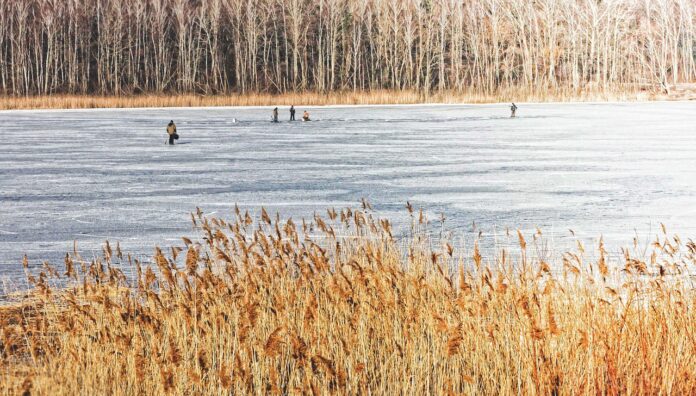Even if you’ve thoroughly checked the ice to ensure a safe ice fishing trip, danger can still strike at any time. That’s why it’s important to be prepared, bring safety equipment and know what to do in an emergency.
Preparing for ice fishing
Thoroughly check the ice. Before you go out on a frozen body of water thoroughly check the ice to ensure it is safe. You can tell the strength and safety of ice by its appearance, thickness and other factors. Clear or blue ice that is at least 4 inches thick is required to safely go ice fishing. Check out my guide on how to determine if the ice is safe enough to go ice fishing to learn how to weigh all the factors that contribute to the integrity of ice on a body of water.
Speak to a local source on the quality of ice on local bodies of water. Ice varies from one body of water to the next. Local bait shops and fishing guides can offer insight to the conditions where you plan to go ice fishing.
Tell someone where you are going. Tell someone where you are going and when you plan to be back. If something does happen, relaying your plan to a responsible adult can help save your life.
Spread out. When you are with a group, avoid walking in a single file line and spread out when you are fishing to avoid putting too much pressure on one spot and to more evenly distribute weight.
Don’t go alone. It’s safer to go with a group or partner rather than alone. If something happens or there is an emergency, someone can call for help and take further life-saving action.
Dress in layers. When going out in freezing temperatures, it’s a good idea to dress in layers. Your base layer should consist of a moisture-wicking layer that wicks sweat away from your body and traps warmth. Your middle layer should consist of fleece or wool clothing. Your outer layer should be insulated and wind and waterproof. Always make sure your head and hands are covered. Wear two layers of socks — moisture-wicking thin polyester socks underneath wool socks. Wear insulated waterproof boots. Always cover your head, neck and your hands. Avoid wearing cotton.
Always bring safety equipment. Always bring a safety kit and personal safety equipment when you go ice fishing. Ice fishing safety equipment includes the following:
- Cell phone or radio
- Dry clothes, gloves and boots
- Hand warmers
- Sled/5-gallon bucket
- Floating rescue rope
- Tape measure
- Cleats/crampons
- Ice picks
- Ice chisel or auger
- Flotation suit or life jacket
- Whistle
- First aid kit
Responding to an emergency
If you fall through the ice:
- Don’t panic.
- Don’t remove your clothing. Heavy clothes trap air and provide warmth and floatation rather than dragging you down.
- Turn yourself towards the direction you came from before you try climbing out. The direction you came from probably has the strongest ice to support your weight when you attempt to climb out.
- Dig your ice picks into the ice with your arms spread out while you kick your feet and pull yourself onto the surface of the ice by sliding forward.
- Do not stand up once you’re out of the ice. Instead roll away from the weak ice. Rolling on the ice will help keep your weight evenly distributed and help keep you from breaking through the ice again.
- Seek shelter, heat, dry clothing and warm non-alcoholic, caffeine-free drinks.
- Seek medical attention if you feel disoriented, are shivering uncontrollably or experience any other symptoms of hypothermia.
If someone you’re with falls through the ice:
- PREACH – Shout to the person that’s fallen through to encourage them to fight to survive and reassure them help is on the way.
- REACH – If you can safely reach the victim from shore, use a rope, ladder or jumper cables to reach them. If they start to pull you in, release the object and start over.
- THROW – Toss one end of a rope something that will float to the victim. Have them tie it around themselves before they are too weakened by the cold to grasp it.
- ROW – Find a light boat to push across the ice ahead of you. Push it to the edge of the hole, get into the boat and try to pull the victim in over the bow. Attach rope to the boat, so others can help pull you and the victim to safety.
- GO – A non-professional should not go out on the ice to perform a rescue unless all other basic rescue techniques have been ruled out.
Hypothermia
Hypothermia is a life-threatening drop in the body’s core temperature.
Symptoms
- Loss of coordination and manual dexterity
- Feeling disoriented or confused
- Feeling fatigued
- Memory loss
- Slurred speech
- Uncontrollable shivering or shaking
Water pulls heat from the body 25 times faster than air. Once someone that’s fallen through the ice is out of water, they need to seek shelter, heat, dry clothing and warm non-alcoholic, caffeine-free drinks immediately. Alcohol should never be given as a means to warm up because alcohol dilates blood vessels allowing cold blood from the extremities to move toward the heart. The trunk area of the body should be warmed first in those with acute hypothermia. Just covering someone suffering from acute hypothermia with a blanket will not generate heat, as the trunk area will have to be actively heated. As the trunk warms up, the limbs can start being warmed also.
If symptoms don’t seem to be resolving or continue to worsen, seek medical attention immediately.
Related Content
- How to stay safe on frozen lakes, ponds
- How to determine if the ice is safe enough to go ice fishing











